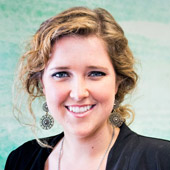CEO & Founder of Motion Infusion; Global Wellbeing Expert; Bestselling Author of "Workplace Wellness That Works"
Laura Putnam Biography
Laura Putnam, MA, author of the award-winning "Workplace Wellness That Works," is CEO and founder of Motion Infusion, a leading wellbeing and learning provider. Her work has been covered by MSNBC, The New York Times, Boston Globe, MSNBC, ABC, FOX News, NPR and many others. She is a former urban public high school teacher, public policy advocate, international community organizer, dancer, gymnast, and now movement-builder in the world of health and wellbeing.
With a mission to focus on “the water, not the fish,” applying a culture-first approach to wellbeing, Putnam is an international keynote speaker, has worked with hundreds of organizations, and has trained over 40,000 leaders and managers around the world. Her LinkedIn Learning course "Managers as Multipliers of Wellbeing" has reached over 30,000 learners.
She is the recipient of the American Heart Association's "2020 Impact" award and the National Wellness Institute’s “Circle of Leadership” award. She is a graduate of Brown University and Stanford University.
Contact a speaker booking agent to check availability on Laura Putnam and other top speakers and celebrities.
Laura Putnam Speaking Topics
-
Workplace Wellness That Works
Infusing well-being into any organization
A healthier, happier workforce is good for people and good for the bottom line. But, are your workplace wellness programs actually working? Probably not. Most don’t. Learn how you can apply a smarter framework that infuses well-being into the workflow, tackles the taboo topic of mental health at work, and makes well-being a way of life.
Key Points:
- Empower employees to make better choices.
- Design and deliver the strategy that your organization needs.
- Drive quantifiable change through more creative implementation.
Target Audience: General
-
Born to Move, Told to Sit
Re-engineering movement back into our lives
It’s less about exercise and more about moving throughout the day (aka, Motion Infusion). To do so, we need to acknowledge the fact that we are “born to move, but told to sit.” That is, everything in our society drives us to our chairs. We need to find meaningful ways to move throughout the day, such as taking a five-minute walk every half hour.
Key Points:
- Learn the science on the unexpected benefits of movement.
- Examine how our culture “conspires” against us being healthy.
- Get out of your seat and in motion through actionable steps.
Target Audience: General
Laura Putnam Videos

Laura Putnam: Leading Workplace Well-Being Expert
Laura Putnam is turning the wellness world upside down. Laura offers unexpected solutions to leverage every workplace, activate key influencers,...

-
How do I book Laura Putnam to speak at my event?
Our experienced booking agents have successfully helped clients around the world secure speakers like Laura Putnam for speaking engagements, personal appearances, product endorsements, or corporate entertainment since 2002. Click the Check Availability button above and complete the form on this page to check availability for Laura Putnam, or call our office at 1.800.698.2536 to discuss your upcoming event. One of our experienced agents will be happy to help you get speaking fee information and check availability for Laura Putnam or any other speaker of your choice. -
What are the speaker fees for Laura Putnam
Speaking fees for Laura Putnam, or any other speakers and celebrities, are determined based on a number of factors and may change without notice. The estimated fees to book Laura Putnam are $10,000 - $20,000 for live events and $10,000 - $20,000 for virtual events. For the most current speaking fee to hire Laura Putnam, click the Check Availability button above and complete the form on this page, or call our office at 1.800.698.2536 to speak directly with an experienced booking agent. -
What topics does Laura Putnam speak about?
Laura Putnam is a keynote speaker and industry expert whose speaking topics include Author, Business, Business Consulting, Corporate Culture, Creativity, Future of Work, Futurism, Health & Wellness, Heart Health, Human Resources, Innovation, Mental Health, Motivational, Public Health, Social Activism, Sports, Sports Motivation, Storytelling, Women, Work-Life Balance -
Where does Laura Putnam travel from?
Laura Putnam generally travels from San Francisco, CA, USA, but can be booked for private corporate events, personal appearances, keynote speeches, or other performances. For more details, please contact an AAE Booking agent. -
Who is Laura Putnam’s agent?
AAE Speakers Bureau has successfully booked keynote speakers like Laura Putnam for clients worldwide since 2002. As a full-service speaker booking agency, we have access to virtually any speaker or celebrity in the world. Our agents are happy and able to submit an offer to the speaker or celebrity of your choice, letting you benefit from our reputation and long-standing relationships in the industry. Please click the Check Availability button above and complete the form on this page including the details of your event, or call our office at 1.800.698.2536, and one of our agents will assist you to book Laura Putnam for your next private or corporate function. -
What is a full-service speaker booking agency?
AAE Speakers Bureau is a full-service speaker booking agency, meaning we can completely manage the speaker’s or celebrity’s engagement with your organization from the time of booking your speaker through the event’s completion. We provide all of the services you need to host Laura Putnam or any other speaker of your choice, including offer negotiation, contractual assistance, accounting and billing, and event speaker travel and logistics services. When you book a speaker with us, we manage the process of hosting a speaker for you as an extension of your team. Our goal is to give our clients peace of mind and a best-in-class service experience when booking a speaker with us. -
Why is AAE Speakers Bureau different from other booking agencies?
If you’re looking for the best, unbiased speaker recommendations, paired with a top-notch customer service experience, you’re in the right place. At AAE Speakers Bureau, we exclusively represent the interests of our clients - professional organizations, companies, universities, and associations. We intentionally do not represent the speakers we feature or book. That is so we can present our clients with the broadest and best performing set of speaker options in the market today, and we can make these recommendations without any obligation to promote a specific speaker over another. This is why when our agents suggest a speaker for your event, you can be assured that they are of the highest quality with a history of proven success with our other clients.
Laura Putnam is a keynote speaker and industry expert who speaks on a wide range of topics such as Workplace Wellness That Works, Born to Move, Told to Sit, Me At My Best and Managers on the Move. The estimated speaking fee range to book Laura Putnam for your event is $10,000 - $20,000. Laura Putnam generally travels from San Francisco, CA, USA and can be booked for (private) corporate events, personal appearances, keynote speeches, or other performances. Similar motivational celebrity speakers are Libby Gill, Dr. Jackie Freiberg, Steven Van Cohen, Kris Boesch and Kristel Bauer. Contact All American Speakers for ratings, reviews, videos and information on scheduling Laura Putnam for an upcoming live or virtual event.
This website is a resource for event professionals and strives to provide the most comprehensive catalog of thought leaders and industry experts to consider for speaking engagements. A listing or profile on this website does not imply an agency affiliation or endorsement by the talent.
All American Entertainment (AAE) exclusively represents the interests of talent buyers, and does not claim to be the agency or management for any speaker or artist on this site. AAE is a talent booking agency for paid events only. We do not handle requests for donation of time or media requests for interviews, and cannot provide celebrity contact information.
If you are the talent and wish to request a profile update or removal from our online directory, please submit a profile request form.





.png)




























